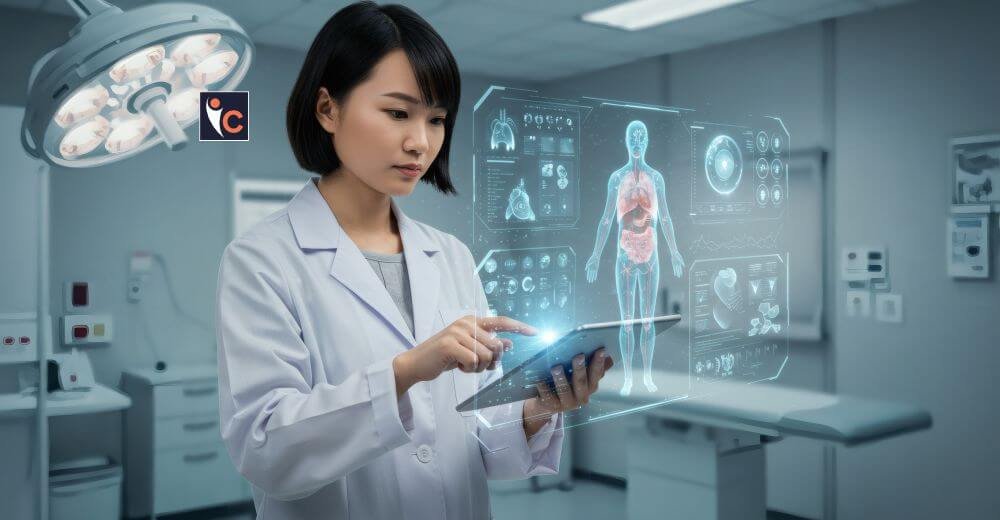Medical imaging has always been one of the essential issues of healthcare, assisting doctors to diagnose, monitor, and treat various conditions. As technology is fast developing, medical imaging with machine learning (ML) is transforming the medical arena. Machine learning is a way of generating new opportunities to eclipse diagnostic precision, human intervention and improve patient outcomes. This strong merge between artificial intelligence and healthcare is opening the door to more productive, customised, and pro-active medical care.
Understanding Machine Learning in Medical Imaging
Machine learning, in essence, is a branch of artificial intelligence whereby computer programs are taught to learn and evolve with time without direct programming. Regarding medical imaging, such ML models are trained using huge datasets of medical images, including X-rays, MRIs, CT scans, and ultrasounds. These systems get trained to recognise patterns, detect anomalies and help medical professionals read complicated images.
Processing and analyzing massive data is one of the principal strengths of ML, as it cannot be performed in sufficient speed and quality by human beings. Radiologists have to coordinate hundreds of images per day, which makes it more likely to experience fatigue and mistakes. Machine learning tools can be considered as an extra pair of eyes, which makes every important detail impossible to miss.
Enhancing Diagnostic Accuracy
One of the biggest uses of machine learning in the advanced imaging of medical processes is the early diagnosis and identification of diseases. As an example, ML can be trained to detect the early symptoms of cancer, heart ailment, neurological disorders, and musculoskeletal conditions. Machine learning algorithms explore mammography in breast cancer screening to equal or even surpass human radiologists when it comes to early-stage discovery of tumors on a mammogram.
Similarly, neurology is one area where ML is being used to detect early signs of Alzheimer in the analysis of MRI. These tools can assist in management by recognizing kernels that are not visible via naked eye, which can begin treatment at its earliest disease onset, slowing down the disease further.
Reducing Human Error and Improving Efficiency
Diagnostic imaging is complex skill that is subject to human error when there is excessive workload or stress. Machine learning will provide a solution through which it offers consistent and objective analysis, which limits variability in interpretation between varying radiologists.
Moreover, ML has the capacity of automating repetitive tasks, including the segmentation of organs, calculating the size of tumors, or identifying regions of interest within a picture. It not only decreases the amount of time spent on this but also permits the healthcare professional to concentrate on more vital issues of patient care leading to increased efficiency of the medical imaging process.
Personalized Medicine and Predictive Analytics
Personalized medicine is also being propelled by the machine learning in medical imaging. ML models give an answer by studying imaging data of a patient in combination with his/her genetic, lifestyle, and clinical data and predicting how a disease could progress or respond to a particular treatment. This degree of understanding allows doctors to develop individual treatment schemes, ensuring a higher possibility of positive outcomes and reducing irrelevant actions.
Predictive analysis that uses ML can even manage to predict which patients will develop some cases prior to the occurrence of symptoms. As an illustration, machine learning analysis of cardiac imaging information is able to estimate the risk of heart attack early enough to enable physicians to prevent it.
Challenges and Ethical Considerations
As large as the benefits of ML in medical imaging are, there are difficulties that should be eliminated. Quality and diversity of training data is one of the concerns. When ML models are trained using datasets that are not diverse (in regard to patient demographics or imaging equipment), then they are likely to be biased or have poor performance on those that they are underrepresented in. Data protection and privacy is also a major concern.
Medical images usually carry delicate patient data, and really strict protocol has to be enforced to guard such data against invasion or abuse.
In addition, it involves the issue of clinical liability. In case the ML system provides a diagnosis suggestion, who is the real decision-maker, the algorithm or the doctor? Easy to understand directions and rules are required to guarantee the safety of the patients and encourage innovation.
Future of Machine Learning in Medical Imaging
The use of machine learning in medical imaging will grow as machine learning evolves further. The integration of ML with such technologies as 3D imaging, virtual reality, and real-time analytics holds a potential of transforming many parts of the diagnostic and surgery planning process.
Interaction of data scientists, medical professionals and technology developers will play a critical role in perfecting these tools and safely and ethically using them. Finally, the ability to incorporate machine learning into the medical imaging process can be used to the benefit of the healthcare field itself and turn it into a more patient-focused and accurate experience than ever.





